Acne is the most common skin condition. According to statistics, more than 80% of the world's population is affected by it. Small and large purulent pimples can appear on the face regardless of gender and age.
This may indicate both functional disorders inside the body and the impact of external unfavorable factors. Therefore, treatment should be started only after understanding the source of the problem.
Record content:
- 1 Types of purulent acne on the face
-
2 The causes of acne
- 2.1 External reasons
- 2.2 Internal reasons
- 2.3 Why appears during pregnancy
- 3 What not to do with acne, can it be squeezed out?
-
4 How to get rid of acne
- 4.1 After 25
- 4.2 After 30-35
- 4.3 After 40-45
- 4.4 In adulthood
-
5 Acne treatment with alternative methods
- 5.1 Oils
- 5.2 Aloe vera
- 5.3 Calendula
- 6 Nutrition and lifestyle
- 7 Acne video
Types of purulent acne on the face
Depending on the presence of infection and the degree of its spread, there are 3 types of purulent acne. In addition to these, there is the primary form of acne - comedones. In some cases, they may precede the formation of abscesses, or remain in the same form for a long time.
Comedones are formed as a result of blockage of the mouth of the hair follicle with sebum and keratinized skin cells. Having no outlet to the outside, the substance becomes denser, thereby expanding the pore.
From the outside, it looks like a black dot - this is the color that fat takes on when oxidized. This form of comedone is called open. The closed form is characterized by deeper localization and looks like a dense white ball.
As a result of inflammation of the clogged mouth, the following types of abscesses may occur:
- Papule. Can be up to 1.3 cm in diameter. The head is convex or slightly raised above the surface of the skin. Has a red or slightly bluish tint. When pressed, it turns pale.
- Pustule. It may develop from a papule or occur primarily. It is characterized by the presence of a visible purulent head.
-
Cysts, nodules. Severe acne in which a large area of the face is affected. Acne is interconnected by sinus tracts, forming conglomerates. They are dense and painful enough.
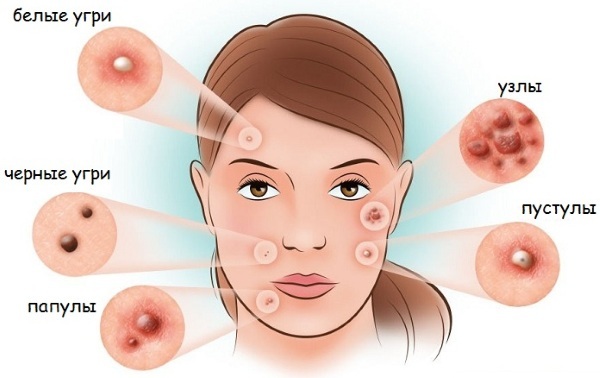
By assessing the quantitative and qualitative composition of acne, you can determine the degree of skin lesions (shown in the table below).
| Acne severity | Number of inflammatory units | Forms of acne | Damage area |
| I | To 10 | Comedones + single papules and / or pustules |
No more than 1/3 of a person. It could be the chin, or the forehead. |
| II | from 10 to 40 | Comedones + inflamed acne. Scars are possible | More than 1/3 of the face. There are rashes on the body (back, chest). |
| III | more than 40 | Comedones (up to 100 units), or inflammatory elements with comedones. Scarring is characteristic | 1/3 to 100% of the face. It also affects other parts of the body. |
| IV | from 5 | Nodular cystic acne, or 100 or more comedones. May be present at the same time in different proportions | From 50% to 100% of the face. May affect the back, chest. |
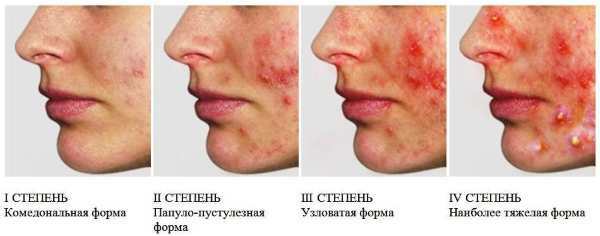
Small pus-filled pimples on the face become a serious problem if their number grows relentlessly. Nevertheless, the severity of the disease is expressed not only in this, but also in the ratio of the forms of inflammatory elements, the area of skin lesions. Only after determining the severity of acne, you can choose the right treatment methods.
The causes of acne
Often the cause of the appearance of acne is heredity or endocrine disorders in the body. They determine the likelihood of skin problems at a given age.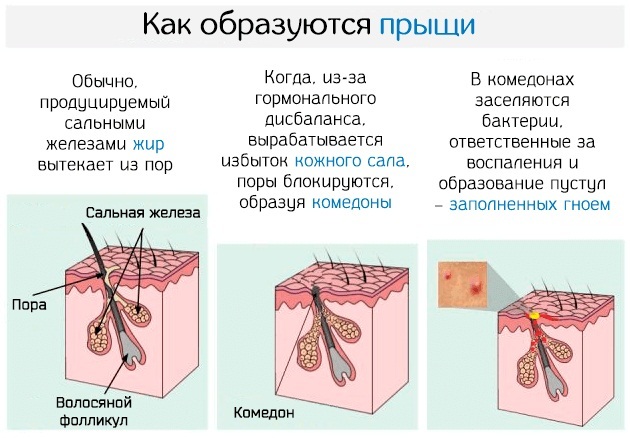 However, there are many factors that trigger the mechanisms of acne formation.
However, there are many factors that trigger the mechanisms of acne formation.
External reasons
They can be both primary and secondary to the appearance of pimples on the face.
The most common ones are:
- Cosmetical tools. Many of them contain comedogenic components - mineral, vegetable and animal oils, petroleum jelly, lanolin. They will moisturize the skin prone to dryness, but for oily skin they will be the cause of blockage of the follicular orifices. As a result, there is a violation of the release of sebum and the risk of developing pathogenic microflora.
- Climate. Prolonged exposure to the scorching sun or wind has a drying effect on the skin. As a result, its protection against the penetration of the pathogen is reduced.
- Stress. Often it leads to a decrease in immunity, which is directly related not only to the health of the body, but also to the condition of the skin.
- Work with hazardous substances (chlorine, petroleum products).
The impact of external factors on skin health at different ages is not the same:
| Causes | After 25 | After 30-35 | After 40-45 |
| Cosmetics | Often | Often | Seldom |
| Solar radiation, other climatic factors | Often | Often | Seldom |
| Stress | Often | Often | Seldom |
| Contact with toxins and ionizing radiation | Seldom | Seldom | Seldom |
If there are no more serious underlying causes of acne, acne will go away soon after the irritation stops.
Internal reasons
Very often, it is the occurrence of acne that indicates the presence of physiological changes or disorders in the body. In some cases, they go away on their own, and sometimes they remain until the provoking factor is eliminated.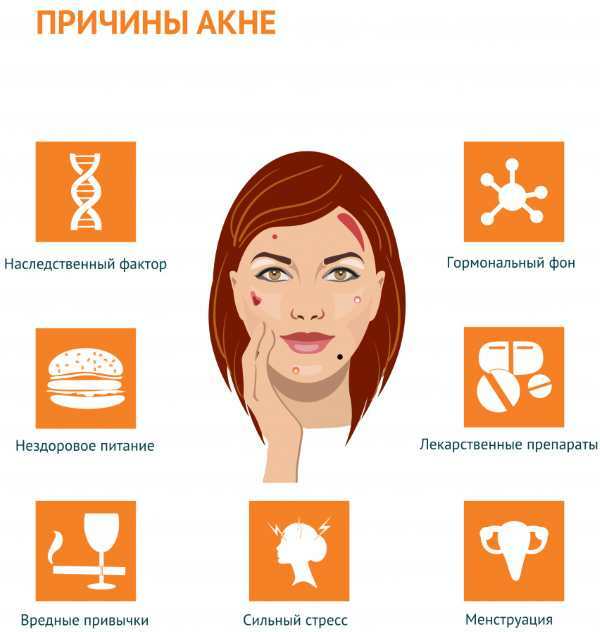
Small purulent pimples on the face can appear for a number of reasons:
- Genetic predisposition. For most people with acne, one or both parents are likely to be affected by the condition.
- Hormonal adjustment. Most often, the appearance of acne provokes a jump in the level of sex hormones - androgens. It can be as a result of adrenal or ovarian dysfunction during puberty - puberty.
- Hyperkeratosis. A prerequisite for the formation of acne may be increased production of cells of the stratum corneum of the epithelium. At such a rate of cell division, the horny scales do not have time to peel off and impede the release of sebum. The result is an excellent environment for bacteria to grow.
- Gastrointestinal disorders. It is associated, for the most part, with a weakening of the immune system.
The role of internal acne factors is different for each age group:
| Causes | After 25 | After 30-35 | After 40-45 |
| Heredity | Often | Often | Often |
| Hormonal changes | Often, it can be associated with both pregnancy and disorders in the endocrine system. | Often, the reasons are:
|
Often, the reasons are:
|
| Hyperkeratosis | Average frequency | Average frequency | Seldom |
| Diseases of the gastrointestinal tract | Seldom | Seldom | Seldom |
Among the most common internal causes of acne development are heredity and hormonal changes. It is they who in 70% of cases lead to the manifestation of the disease.
Why appears during pregnancy
During pregnancy, there is a sharp jump in female sex hormones - estrogen and progesterone. Their relationship with androgens, the so-called male hormones, changes dramatically, the usual balance is disturbed. The production of sebum increases significantly, which is the cause of acne. It normally goes away after the first trimester.
What not to do with acne, can it be squeezed out?
Small purulent pimples on the face do not always go away by themselves and require long-term treatment. Despite the aesthetic side of the problem, there are a number of contraindications that should be adhered to in order to avoid deterioration of the condition:
-
Squeezing out acne. Mechanical extraction of comedones or pustules is fraught with further spread of infection. This can provoke not only the appearance of new acne, but also blood poisoning. If the cause of acne is hormonal changes or heredity (hypersecretion of sebum), then only complex treatment will help.

- Scrubbing in the presence of inflamed elements. At first glance, the surest way to solve the problem is to cleanse the skin. However, in this case, the scrub injures the skin even more, provoking an inflammatory process.
- Foundation and concealers. The occurrence of acne is provoked by a blockage of the sebaceous glands. Applying thick makeup even more blocks the outflow of sebum and oxygen supply, worsening the condition.
Sometimes women hesitate to treat their skin, preferring to squeeze out or mask acne. However, the positive result passes quickly, and the problem remains unsolved.
How to get rid of acne
Acne can be a consequence of serious health problems and then recovery can only be achieved through comprehensive treatment. This may require consultation of both a dermatologist and an endocrinologist or gynecologist. Only a specialist will determine the cause of acne and prescribe competent medication.
After 25
Acne is often associated with puberty, which usually ends by 18-20 years. However, in some cases, it can return after a short or long absence. Depending on the cause of acne, the doctor may prescribe both local and systemic drugs (shown in the table below).
| Pharmacological Group | Drugs | Description | In what cases is assigned |
| Antiseptics | Streptocide; Effezel; Ichthyol ointment; Benzoyl peroxide |
They have an antimicrobial effect, disinfecting the skin and preventing the formation of pus. | In the presence of inflammatory elements, with comedones - inappropriate. |
| External antibiotics | Zenerite; Metrogyl; Klenzit C; Levomikol |
Affect pathogenic microflora localized in / on the skin. | With II, III and IV degrees of acne. |
| Systemic antibiotics | Tetracycline; Erythromycin; Lincosamides |
Suppress the growth and development of a pathogen that has already penetrated the internal environment of the body. | With III and IV degrees of severity of acne. |
| Hormonal drugs (oral contraceptives) | Diana-35; Jess; Janine |
They normalize hormonal levels by increasing or decreasing the level of androgens. | With III and IV degrees of acne, less often - II. |
| Retinoids | Roaccutane; Retinol palmitate (vitamin A); Retinoic ointment |
They are able to affect all links of the pathological process: sebum production, hyperkeratosis and pathogenic microflora. | At III and IV stages of acne, when other methods of therapy have not yielded positive results. |
| Combined drugs | Klenzit-S; Epiduo; Isotrexin |
Contains retinoids and antibiotics. | At stages II and III. |
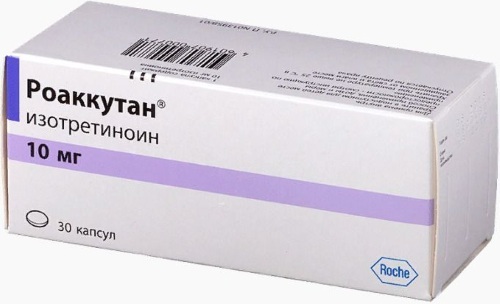
Small and large purulent acne on the face is more effectively eliminated with the help of retinoids and hormonal drugs. At advanced stages, when the infection has penetrated and spread throughout the body, one cannot do without systemic antibiotics.
After 30-35
Less than 10% of women over the age of 30-35 suffer from acne. It can be a progressive form of "teenage" acne or signs of diseases such as polycystic disease or impaired glucose tolerance.
If the acne is mostly comedones, topical treatment will suffice.
For this, drugs are used:
- With salicylic acid. These can be lotions or creams. Promotes exfoliation of dead skin cells and dissolution of acne plugs.
- With antibacterial action. In the form of gels and creams. They may contain antibiotics or have a bacteriostatic effect (azelaic acid, benzoyl peroxide, other antiseptics).
- Based on hormones. Hydrocortisone ointment and analogues.
In more severe stages of acne, topical medications rarely work. Therapy is supplemented with hormonal contraceptives (in case of suspicion of polycystic disease, or hyperprolactemia), or systemic antibiotics and retinoids (in case of infection into the bloodstream).
After 40-45
Sebum production gradually decreases with age, but this does not mean that dry skin is less prone to acne. If the epidermis is not provided with additional moisture, then the protective barrier against the penetration of pathogens will be broken.
Pharmacy preparations that not only moisturize, but also have bacteriostatic and cleansing effects:
- Salicylic acid;
- Metrogyl gel;
- Effezel;
- Ichthyol ointment;
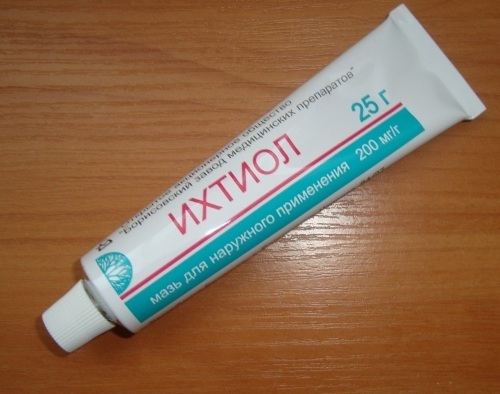
- Hydrocortisone ointment.
During premenopause, hormone replacement therapy is often prescribed. It helps to relieve unpleasant symptoms and prevent possible complications.
In adulthood
The age of acne has increased markedly over the past decades. If earlier young people up to 18-20 years old were exposed to it, today the age bar has risen to 45 and above. This may be a relapse of a long-standing disease, or a disruption in the endocrine system.
It is recommended to eliminate small purulent pimples on the face with the use of gentle preparations that do not have serious side effects.
It can be:
- ointments and creams with antiseptic and antibacterial action;
- preparations with azelaic acid;
- retinoids.
The use of systemic antibiotics and hormonal drugs in mature women can be associated with health risks.
Acne treatment with alternative methods
In the arsenal of nature there are many plants, whose medicinal properties have long been used in cosmetology and medicine. Green tea and aloe vera are often found in facial cleansers, and jojoba oil in moisturizing mousses and creams.
You can make your own acne remedy. Below are recipes that are used both to eliminate comedones and to treat inflammatory elements.
Oils
They moisturize well and serve as an excellent prophylactic agent, preventing the skin from drying out and reducing its protective properties.
The most effective are:
-
Tea tree oil. It also has a healing, antiseptic effect. Apply 2-3 drops of oil to a cotton swab and apply to the problem area for 5-10 minutes.

- Jojoba oil. Due to its chemical similarity with sebum, it does not clog pores and perfectly moisturizes. Apply 5-6 drops to a cotton pad and apply to the pimple. Withstand this for several minutes.
- Juniper oil. It is used not only for acne, but also for various dermatitis and eczema. Apply 1-2 drops of oil to gauze or a piece of cotton wool and apply to the problem area for 5-10 minutes.
Test oils on a small area of skin before using them, as they may cause an allergic reaction.
Aloe vera
It has antibacterial and healing properties.
It is used both unchanged and as tinctures:
- Rubbing with juice. Pour boiling water over the cut aloe leaf and put in the refrigerator in the vegetable storage section for 1.5 weeks. Remove the skin on one side and wipe the face with the pulp 2 times a day.
- Alcohol tincture. Pour aloe juice with alcohol in a ratio of 4: 1. Wipe the skin 1-2 times a day. Keep refrigerated.
- Egg white mask. Beat one protein and combine with 1 tsp. l of aloe juice. Add a few drops of lemon juice. Apply to face and leave for 15-20 minutes. Then rinse off.
You can buy aloe vera gel in pharmacies. It is used as an independent remedy or infusions are prepared.
Calendula
This plant not only promotes the healing of inflamed elements, but also helps fight small scars.
There are several ways to prepare the infusion:
- 2 h l of crushed raw materials pour 100 ml of boiled water. Insist for 7-10 minutes. After cooling, moisten a cotton pad or napkin and apply to the problem area for 25 minutes. The course is 20-45 days, 1-2 times.
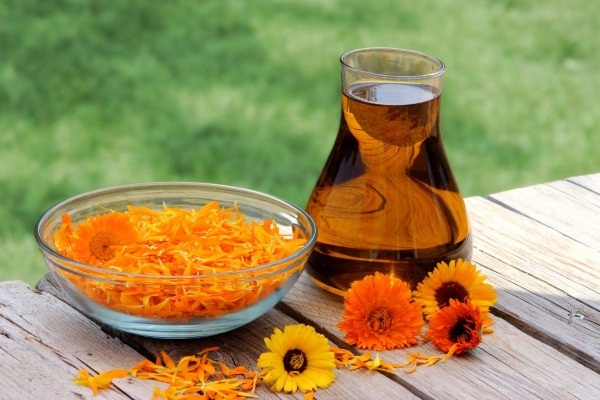
- 2 tbsp. l. Pour 100-150 ml of finely chopped flowers of vodka or alcohol. Insist the product for a week in a dark place. Keep refrigerated. Wipe your face with it 1-2 times a day.
- 2 h l of alcoholic tincture of calendula, dilute in 200 ml of water, add 2 tsp. l honey. Wipe your face with the product 1-2 times a day. Store the composition in the refrigerator.
Calendula solution can be used as a lotion for the treatment of purulent formations and a wound healing agent.
Nutrition and lifestyle
Treatment of acne and acne is not limited to medications and skin cleansing. It is also necessary to review the diet and the presence of bad habits, which can become a decisive factor in the progression of the disease.
For effective therapy and prevention of acne, you must adhere to a few simple rules:
- Daily skin care. Use cleansing lotions and toners that suit your skin type. For combination and dry types, do not use products for oily skin. Do disinfecting lotions for the face regularly.
- Eliminate sweets, starchy foods and foods high in fat from the diet. The appearance of acne is often provoked by foods with a high glycemic index. The exception is durum wheat.
- To give up smoking. Nicotine destroys collagen fibers, reducing the elasticity of the skin and its protective properties.
- Touch your face with your hands as little as possible.
- Drink 1.5-2 liters of water per day.
A healthy and active lifestyle alone will not cure acne, but with proper treatment, it can speed up the healing process with minimal health cost.
Acne or inflammatory skin disease affects women of all ages. However, most often it first occurs during puberty and may recur during life.
Small purulent pimples appear both on the face and other parts of the body, and then a severe stage of skin lesions is diagnosed. Treatment of acne is effective after determining the cause and severity of the condition.
Acne video
Acne causes and the most effective remedy:



